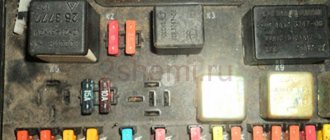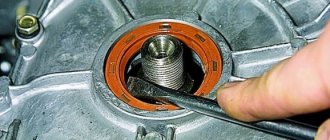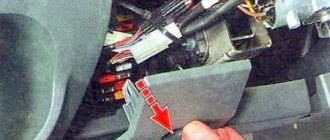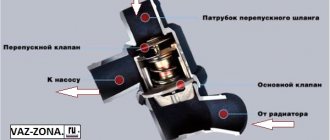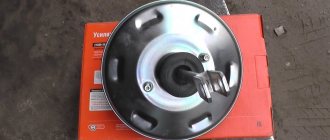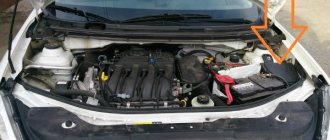General information about the car.
VAZ-2115 Samara-2 is a front-wheel drive sedan, the first representative of the updated Samara family of cars.
The VAZ 2115 car is the founder of the family codenamed Samara-2. The model range includes the 3-door VAZ 2113 hatchback, the 5-door VAZ 2114 hatchback and the VAZ 2115 sedan itself. The Samara-2 family is a modernization of the VAZ 2108, 2109 and 21099 models, respectively.
In 1997, the VAZ 2115 sedan began to be assembled at Pilot Industrial Production (EPP); in 2001, assembly began on the factory assembly line. Currently, the VAZ 2115 is on wide sale; three versions are available: standard (21150-20), norm (21150-21) and luxury (21150-22). In terms of price, the car occupies an intermediate position between the Samara and the tenth family.
The appearance of the car has noticeably changed - the front and rear parts have been changed, the interior has been updated, while the sides, doors and roof remain the same. The new model is distinguished by the front part of the body with original headlights, a modified shape of the hood and front fenders, new taillights with an insert between them, bumpers painted in body color, a trunk spoiler with an additional brake light, door moldings, door sill fairings, a new trunk lid with floor level connector. New efficient lighting technology is provided. The modernization has noticeably improved, modernized the appearance of the car, and also improved the aerodynamics of the car.
The interior of the VAZ-2115 car has become more comfortable, a new, more convenient and advanced instrument panel has appeared, which has a more streamlined and ergonomic shape, backlit push-button switches and indicator lamps (the so-called “European panel”), an adjustable steering column, a steering wheel from the “tenth” "family, "console" between the front seats. The new heater design provides efficient heating of the interior. The standard equipment includes an on-board driver warning system for closing the door locks, unfastened seat belts, leaving the ignition key in the lock, the level of oil and coolant in the engine, and extreme wear of the brake pads. The luggage compartment has become more spacious and convenient due to the increase in the trunk lid. The power units are similar to the VAZ-21099.
The cars use 1.5-liter gasoline engines, both carburetor and with an electronic fuel injection control system with a 5-speed manual gearbox. Initially, modifications with a carburetor engine were produced. In 2001, a modification of the VAZ 2115i was released with an injection (VAZ 2111) engine with distributed fuel injection. To increase service life and reduce noise at idle, a new clutch driven disc with an idle damper is provided.
Purpose of the oil pump on the VAZ 2114 and VAZ 2115
The main task of the oil pump is to create excess pressure in the engine lubrication system and ensure continuous circulation of oil in the lubrication channels.
Only rotary oil pumps are installed on the VAZ 2114
Any breakdown of the oil pump leads to a drop in lubricant pressure, after which the friction between the moving parts of the engine increases sharply. As a result, almost all engine components are damaged, and they can only be restored after an expensive overhaul.
Types of oil pumps for VAZ 2114 and VAZ 2115
The design of the VAZ 2114 and VAZ 2115 engines is the same. Therefore, the oil pumps on these machines are also exactly the same. These are adjustable rotary pumps equipped with a pressure reducing valve.
Main design elements of the rotary adjustable oil pump VAZ 2114
On earlier VAZ models, gear oil pumps were installed, but VAZ engineers gradually abandoned these devices, since the rotary oil pump has important advantages:
- rotary oil pumps, unlike gear pumps, almost never foam the engine oil in the system;
- if an adjustable rotary oil pump is installed on the car, then the car owner will not have to change the engine oil too often (since the foaming problem has been solved, the working life of the lubricant increases on average by 2.5 times);
- Due to the design features, the oil rotary pump significantly facilitates engine operation. When using oil pumps of this type, engine power increases by 35%.
Location of oil pumps on VAZ 2114 and VAZ 2115
The oil pump on the VAZ 2114 and VAZ 2115 is located under the car engine. It is covered by an oil pan, and the pan, in turn, is covered by a crankcase protection. Therefore, in order to get to the oil pump, the car owner will have to remove these parts, having first driven the car onto an overpass or inspection hole.
To get to the oil pump, you will have to remove the pan and crankcase from the VAZ 2114
What is under the hood of the VAZ 2114
Under the hood of the VAZ 2114 its key mechanisms are located. First of all, this is an engine - four-cylinder, single-row, with 8 or 16 valves. From the receiver, compressed air enters it and passes through the air filter (to the right of the engine).
In addition, under the hood of the 2114 there are:
- The windshield washer reservoir is to the left of the engine.
- The hydraulic tank for the brake system is just above the air filter.
- The battery is in the lower right corner.
- The cooling system expansion tank is on the right, above the battery.
- Fuel system adsorber - between the hydraulic drive reservoir and the expansion tank of the cooling system.
- The gearbox is under the engine, on the right side.
The adsorber on the VAZ 2114 appeared in order to comply with Euro-2 and Euro-3 environmental standards. It is designed to capture spent fuel vapors that have not liquefied. With the help of an adsorbent (usually activated carbon), the vapors are absorbed. A malfunction of the device is indicated by a characteristic hissing sound when opening the fuel tank, and a drop in engine speed at idle.
Another video with an example of replacement
The VAZ-2114 car uses a hidden engine cooling circuit with an injector. It is highly complex and includes 28 elements. Traditionally, the assembly of the cooling system of this car is not of high quality. Therefore, throughout the entire period of operation, it requires constant monitoring, regular maintenance and repair. In this regard, many owners of this car are interested in the nuances associated with independent maintenance, repair and operation of the cooling system, among which the most common questions are:
- 1. How to properly replace the coolant mixture?
- 2. How to flush the cooling system?
- 3. How to remove air from the VAZ-2114 cooling system?
- 4. How to properly replace the cooling system pipes?
How does the VAZ 2114 engine work?
The base design of the VAZ fourteenth series engine is an injection system. It is based on distributed fuel injection into the cylinders through electromagnetic injectors - injectors equipped with sprayers. The composition of the fuel-air mixture is regulated by an electronic controller that receives information from the vehicle's sensors.
The first injection engines at VAZ were put into mass production back in 1996. However, they did not gain popularity at first, since the serviceability of the injectors, spark plugs and fuel pump was highly dependent on the quality of the fuel. The difficulty of diagnosing the injection device also had an impact. After modernizing the injection system, the production of VAZs with carburetor engines was completely discontinued by 2006.
The engine operating cycle consists of the following stages:
- When the ignition is turned on, the injection system controller starts the fuel pump using a relay.
- From the pump, the fuel passes through a fine filter, fuel lines, and is supplied to the fuel rail, which is mounted on the intake manifold.
- The fuel pressure regulator, which is located on the ramp, bleeds “excess” fuel back into the tank. This is necessary for accurate dosing of fuel injection.
- From the ramp, through the sprayer on the injectors, fuel is supplied to the intake manifold of the engine cylinders.
- Next, the spent fuel vapors are captured by a separator, from where the vapors condensed into liquid are drained back into the tank. The air passes through the air filter and enters the throttle body intake hose. If the car is equipped with an adsorber, then part of the vapor is absorbed by activated carbon.
Thus, the necessary elements for the operation of the VAZ 2114 injection engine are:
- fuel pump – electric, submersible type, with a working pressure of at least 3.2 bar;
- electronic fuel injection system controller;
- pressure control fitting and fuel pressure regulator, which are attached to the fuel rail;
- electromagnetic valves – injectors;
- cleaning filter system and throttle assembly.
All control of the distributed fuel injection system is carried out through the ECU - an electronic control unit. It reads the vehicle's sensors and controls the operation of the fuel system. Since the operation of the entire vehicle depends on the health of the ECU, it is not recommended to try to reflash it yourself.
Specifications
Power unit
Description of the VAZ-2115 fuel pump injector
Over the 10 years of serial production of the Lada 2114, several power units were placed under its hood. First, it is worth mentioning the 1.5-liter, 8-valve engine, which developed 78 horsepower and 116 Nm. This engine consumed about 7.3 liters for every 100 kilometers in combined mode.
This modification has an injection intake controlled via an electronic unit, replacing the obsolete carburetor intake. Not without a new camshaft with adjusted phases. After AvtoVAZ introduced an injector into the VAZ-2114 engine, a group of engineers increased the efficiency of the engine, adding power to it. On the other hand, it was also possible to reduce the “fuel appetite”.
In 2004, a modification of the power unit was released, with a displacement of 1.6 liters. The engine already produced 81 horsepower and 125 Nm. In combined mode, the engine consumed 7.6 liters per hundred kilometers. The eight-valve injection power plant has an increased volume thanks to the cylinder height increased by 2.3 millimeters, which provided a longer piston stroke.
Instead of the ignition module, they began to install a coil. The new version of the engine has become more powerful and environmentally friendly, but gasoline consumption has increased when compared with the first 1.5-liter engine. In addition, in the same year they released a 1.6-liter version of the engine with a 16-valve system.
Such an engine already produced 89 “horses” and 131 Nm of rotational force. Based on the passport data, for every 100 kilometers you need 7.5 liters of gasoline in combined mode. In 2007, this engine was subjected to serious modification. The working volume remained at the same level – 1.6 liters. But power increased to 98 horsepower and 145 Nm of torque.
It’s nice that the increased power did not negatively affect the “fuel appetite”. According to the passport data, the new product consumes 7.2 liters of gasoline per 100 kilometers. They worked hard on the previous VAZ-2114 engine for 3 years and made several changes.
Engine with a displacement of 1.6 liters.
The connecting rod and piston group was lightened by as much as 39 percent. The drive of the gas distribution mechanism was changed - now it was tensioned automatically. The valve wells have become smaller in size. The quality of cylinder honing has increased significantly.
Transmission
All power plants of the VAZ-2114 work together with a five-speed manual transmission, which has been improved. All torque potential is transmitted exclusively to the front wheels. Both the transmission and the suspension were developed only by Russian engineers.
Chassis
The car was built on the platform of the previous model - the time-tested "nine" (VAZ-2109), which was subjected to serious modernization. The front wheels operate with McPherson struts, and the rear wheels with trailing arms or coil springs. Driving the car does not cause the most pleasant sensations, since there is no power steering.
The steering wheel itself is made of a rack and pinion type. The braking system of the domestic hatchback received disc brakes at the front and drum brakes at the rear. If we take the average speed limit of 80 kilometers per hour, then the braking distance with passengers will be 40 m.
Safety
It’s not very pleasant to talk about the safety level of the Lada-2114. The car does not have airbags and the body metal is too thin, which is not capable of providing the proper level of protection in an emergency. The vehicle is severely deformed even with mild impacts, so it is advisable not to drive at high speeds.
Modifications
The VAZ 2115 manufacturer offers consumers a choice of several configurations, on which their cost depends:
- One and a half liter carburetor engine. In this case, the car is marked as VAZ 2115-01.
- An engine with the same volume, characterized by the presence of a distributor fuel injection system. In addition, the car is also equipped with electronic control and is labeled as VAZ 2115-20.
Dimensions of the “fifteenth” Lada
Car electrical equipment
VAZ 2115 injectors or carburetors use a single-wire electrical circuit. In this case, the negative terminal of the power supplies is connected to the minus, and the positive terminal itself is supplied with a separate wire.
As a result of the fact that the VAZ 2115 carburetor and injector have certain differences, there is also a difference in the design features of the wiring:
- In injection versions, the wiring harnesses are slightly larger in size as a result of the fact that the system is equipped with additional regulators and other electrical equipment.
- As a result of the change in the circuit, changes were made to the design of some electrical circuits.
- In addition, the layout of some of the electrical components as a whole was changed.
Wiring diagram on the “fifteenth” Lada On VAZ 2115 cars, as on its predecessors, the process of repairing the electrical wiring diagram and equipment usually leads to damage to the fixing clips. In any case, if these elements are damaged, they must be replaced, otherwise the electrical wiring may be very close to the hot motor, which will damage it.
Machine electrical protection
The electrical circuit, in particular, the power circuits in these car models are protected from various damages using fuses. The cost of these elements in stores is minimal, but they play a very important role and must always be in working order.
Fuses do not protect only:
- car battery charging diagram;
- ignition circuit;
- electrical circuit for powering the generator and starter.
Electrical equipment is protected by a block in which all fuses are collected, and this block is located in the engine compartment. Electrical equipment such as a starter, windshield wipers, as well as optics are connected to the general circuit via a relay. The relay is also installed in the block. In general, the electrical circuit of the wiper motor and optics is protected by bimetallic reusable elements.
Injector relay block
So, how is electrical equipment protected on domestic cars:
- fuses on the block, which are designed to protect various elements of equipment, are marked as F1-F20;
- K1 is a device that protects the optical cleaner circuit;
- K2 - is responsible for the functionality of the light alarm, as well as turn signals;
- K3 - the element ensures the functionality of the windshield wipers;
- K4 - the device protects the electrical circuit of optics, in particular, incandescent light bulbs;
- K5 - if the car is equipped with electric window regulators, then this relay is responsible for their performance;
- K6 - car steering horn;
- K7 — rear window heating system device;
- K8 - long-range vehicle lighting;
- K9 - low-beam vehicle lighting.
It should be noted that the lamps for the fog lights in the rear headlights are protected separately. For this purpose, a fuse is used, installed in the vehicle interior under the center console. It is located in the wiring harness, next to the optics power button.
What do the tidy indicators do?
The control panel on the VAZ 2115 is located in the center console directly in front of the driver.
Descriptions of instrument cluster symbols are given below:
- Coolant temperature sensor, if the controller arrow moves into the red zone, this indicates that the power unit is overheating.
- A tachometer informs the driver about the crankshaft rotation speed; if the arrow falls into the red zone, it is necessary to reduce the engine speed.
- Left turn signal.
- Right turn signal.
- A speedometer that tells you how fast a vehicle is moving.
- Fuel level sensor in the tank.
- The light indicator, made in the form of a gas pump, usually lights up if there is no more than 7 liters of fuel left in the gas tank.
- Optics indicator, activated when the side lights are turned on.
- In accordance with the instructions, an indicator in the form of an exclamation mark lights up on the instrument panel if the brake fluid level has dropped and reached a minimum.
- High beam activation indicator light.
- This is a button designed to reset the daily mileage on the odometer and set the clock.
- An odometer that records the mileage of a vehicle.
- Light alarm, when turned on, this indicator will blink.
- The icons include one important indicator - Check Engine. This symbol always flashes when the engine starts, but disappears after it starts. The indicator may appear if the control unit detects certain problems in the operation of the power unit.
- The display showing the outside temperature and time is switched using button 11.
- The battery icon appears when the ignition is turned on; if it is constantly on, then most likely the on-board computer has detected problems related to the battery charge. But if it occurs, the problem may also be caused by a malfunction of the generator, loosening of the strap, or breakdown of the unit.
- The letter P in a circle - the indicator appears when the car is setting the parking brake.
- This symbol lights up when the engine fluid pressure is too low.
- Reserve indicator (the author of the video about tuning the control panel at home is the Studio Pandora channel).
